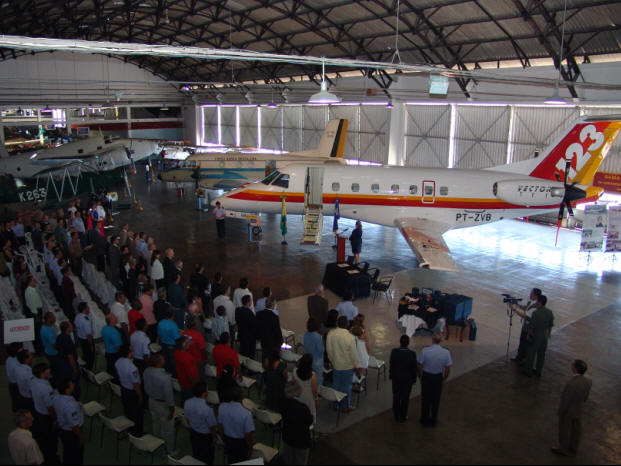
 |
NEWSROOM |
|
|
|
||||
Restored Embraer CBA 123 Aircraft Delivered To MusalBy Antonio Percy |
||||
 |
August 20, 2009: Sao Jose dos Campos, Brazil– Embraer delivered the second prototype of the CBA 123 airplane, to the Aerospace Museum (Museu Aeroespacial – MUSAL). The ceremony was held at the museum, at Campo dos Afonsos, in the city of Rio de Janeiro, Brazil. Embraer restored the aircraft as part of the activities in commemoration of the Company’s 40th anniversary, and it will be on display in the main exhibition hall, next to the first prototype of the Bandeirante, which was the first airplane manufactured by Embraer. “It is a great honor for Embraer to see the CBA 123 exhibited in Brazil’s largest aerospace museum,” said Pedro Ferraz, Director of the Embraer Education and Research Institute. “We have a very special place in our hearts for this airplane. Although it was not produced in series, for commercial reasons, the CBA 123 represented a significant technological advance for Brazil’s aeronautics industry. It will undoubtedly be well cared for at the MUSAL.” |
|||
|
Students in the general mechanics course of the National Industrial Apprenticeship Service (Serviço Nacional de Aprendizagem Industrial – SENAI) participated in the restoration of the second prototype of the CBA 123, tail number PT-ZVB, which was concluded last May. The airplane was exhibited, in June, to employees at Embraer’s headquarters, in São José dos Campos, outstate São Paulo, and later transferred to Rio de Janeiro. “We are very proud to receive the CBA 123, which will further enrich MUSAL’s collection,” said Air Force Major-General Márcio Bhering Cardoso, the museum’s Director. “We already have other historic Embraer airplanes, like the Bandeirante, the Xavante, and the AMX. Now, visitors will get to know another aircraft produced by the Company.” The MUSAL, which was founded in 1973, covers 163,500 square feet (15,195 square meters), including a two-story building and five hangars. The exhibition rooms hold the main historical collections of aviation pioneers and the main hall shows the museum’s oldest aircraft to an average annual attendance of 60,000 visitors. |
||||
|
An aeronautical cooperation agreement between Brazil and Argentina, in 1987, led a partnership between Embraer and FAMA (Fábrica Argentina de Material Aeroespacial) to develop the CBA 123 (CBA stood for Cooperation between Brazil and Argentina), which was commercially called Vector. The CBA 123 was a sophisticated and modern airplane that offered significant improvements, in terms of technical innovation, speed, safety, and comfort. Equipped with a “pusher” type propeller that was installed at the rear of the fuselage, the aircraft was designed for 19 passengers. The certification campaign had two prototypes, and the first flight was made by the aircraft with registration PT-ZVE, on July 18, 1990. The advanced design showed to be incompatible with market expectations, which in the early ‘90s experienced a sharp crisis, following the Gulf War, making it economically unfeasible and causing it to be canceled. The technical cooperation agreement with the Argentine industry was discontinued in 1991, and the project was finally terminated in 1995. Several of the technologies developed for the CBA 123, however, were later incorporated into the ERJ 145 program. |
| ©AvStop Online Magazine Contact Us Return To News |